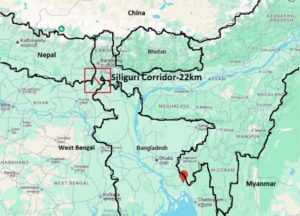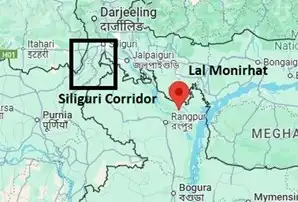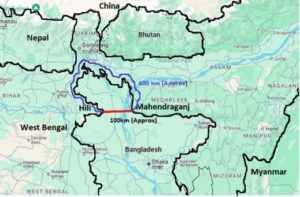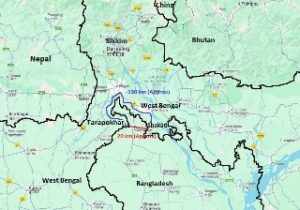India’s strategic lifeline and growing concern

Fix the alternative route to the inland northeast
In the complex geopolitical landscape of South Asia, few regions have strategic vulnerabilities and national importance as India’s Siliguri Corridor. This narrow 20–22 km wide land, commonly known as the “chicken neck”, is the only land link between mainland India and its eight northeastern states. With the shift in regional dynamics (especially involving China, Bangladesh and Myanmar), the Siliguri Corridor has become a key issue in India’s security and connectivity strategies.

The strategic significance of the Siliguri Corridor
The Siligri Corridor geographically wedges into the west of Nepal, the northern part of Bhutan, the northern part of Bangladesh, and the southern part of Bangladesh. It provides essential road, railway and defensive connections to the Northeast, which covers about 262,2330 square kilometers (about 8% of mainland India) and has the location of more than 40 million citizens.
This corridor not only supports military mobilization, but also promotes 95% of exports from northeastern states such as Assam, Meghalaya, Manipur, Nagaran and Arunachal Pradesh. Whether through conflict, blockade or geopolitical tensions, it can seriously undermine opportunities for these countries and affect national integrity.

Close to China and the rise of threats
The corridor is uncomfortable close to Tibet’s Chumbi Valley, where the area rapidly expands its military infrastructure. In the event of conflict, this proximity could allow China to cut off corridors and cut off the northeast from other parts of India. This situation reflects the Dokram standoff in 2017, highlighting the need for India to strengthen its defense and develop alternative routes.
The challenge is China’s growing influence in neighboring countries. Through infrastructure investment and strategic partnerships, especially in Myanmar and Bangladesh, China is slowly reshaping regional balance.
Lalmonirhat Airbase Revival: Gray Regional Threat
One of the latest and shocking developments is the proposed revival of the Lalmonirhat Airbase in northern Bangladesh, just 135 km from the Siliguri Corridor. Originally built in 1931 and used during World War II, the air base has been dormant for decades. However, the report shows that with China’s assistance, interest in operating it has increased. Despite being an economic initiative, Indian intelligence sees it as a potential surveillance and logistics hub for China. If developed, air bases could enhance China’s intelligence, surveillance and reconnaissance (ISR) capabilities, posing a major threat near the Indian strategic corridor.
Diplomatic warnings and regional tensions
Assam Chief Minister Himanta Biswa Sarma recently issued a clear warning, noting: “India has a chicken’s neck, but Bangladesh has two.” His comments remind people that there is territorial vulnerability on both sides and that any attempt to develop the Indian Corridor may cause countermeasures. The interim government of Bangladesh led by Muhammad Yunus has also attracted attention, and Muhammad Yunus seems to be closer to China’s strategic interests. This shift could complicate India’s efforts to ensure its Northeast connectivity.
Need to replace the connection
Given the rising risks, India must diversify its opportunities to enter the Northeast. Relying on Siliguri corridor alone is no longer feasible. Several alternative options have been explored or proposed:
Hili – Mahendraganj Transnational Corridor
The proposed corridor will connect Heli (West Bengal) to Mahendraganj (Meghalaya) through Bangladesh, completely bypassing the Siliguri route. An eight-lane highway could be developed to provide India with a faster and safer connection to the Northeast. In return, Bangladesh may receive annual transportation fees, similar to China’s $13.6 million in oil and gas pipeline transportation that paid Myanmar.

Tarapokhar – Shakati Elevated Corridor
Another way to bypass the Siliguri corridor may involve the establishment of a transport route between Tarapokhar, located on the western India-Bangladesh border in the northern Uttar Dinajpur district of western West Bengal, and Shakati on the eastern border of Jalpaiguri region. The proposed corridor will reduce the travel distance from about 131 km to only 20 km, reducing the dependence on Siliguri extension. India can draw inspiration from the Qatarpur Corridor with Pakistan, an initiative that proves that even highly sensitive cross-border projects are possible driven by strategic vision and diplomatic cooperation.

The secondary infrastructure of the Siliguri Corridor
In addition to external alternatives, India can also develop underground infrastructure within the Siliguri corridor itself. Underground tunnels for roads, rail, utilities and communications will reduce contact with air threats and increase safety. Global precedents exist: Japan’s Yamamen Tunnel, 18.2 km below Tokyo, China’s 18 km below the Qinling Mountains, demonstrates the feasibility of such an ambitious project. Similar innovations from Siliguri can also protect this critical link, while being continuously accessible even during hostilities.
Caratan Multi-Mode Transport Corridor
In a speech by Bangladesh interim leader Muhammad Yunus, who called the northeast of India “inland” during his visit to China, New Delhi imposed restrictions on Bangladesh exports and accelerated alternative connection plans to bypass Bangladesh. At the heart of this strategy is the Karadan Multi-Mode Transportation Project (KMMTTP), which aims to connect Kolkata to Mizoram through Myanmar. India has stepped up efforts to complete the KMMTTP, which aims to provide a more direct pathway from Kolkata to the Northeastern state. The project is already partially operating and the Indian government is now accelerating the rest of the work.
KMMTTP consists of three main parts: a maritime operation about 539 kilometers from the port of Kolkata to the port of Sittwe in Myanmar; a Karadan River from Sitway to Paletwa extends about 158 kilometers along the inland waterway of the Karadan River; and a 110 kilometers from Paletwa to Zorinpui on the border of India-Myanmar. Starting from Zorinpui, the route connects to Mizoram and integrates with India’s existing road infrastructure in the Northeast.
Strategic urgent
The Siliguri Corridor is more than just a passage, it is a strategic lifeline that forms India’s unity and regional stability. India must act decisively with China’s growing threat in South Asia and the threat of potential vulnerability from its neighbors.
It is necessary to build alternative corridors through Bangladesh and Myanmar, strengthen existing corridors through advanced infrastructure and maintain diplomatic leverage on regional transport routes anymore. Protecting the Siliguri Corridor and ensuring uninterrupted access to the Northeast is not only a matter of regional development, but also a matter of national survival and strategic vision.
Disclaimer
The views expressed above are the author’s own.
End of the article






